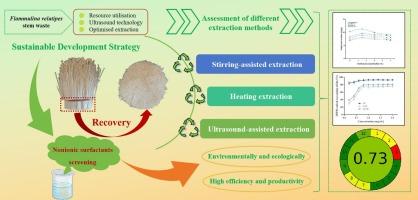非离子表面活性剂联合超声辅助提取金针菇茎废弃物中生物活性多酚的优化研究
IF 9.7
1区 化学
Q1 ACOUSTICS
引用次数: 0
摘要
食用和药用蘑菇的培养过程产生了大量的生物质废物,这些废物可以成为生物活性化合物的丰富来源。本研究旨在优化金针菇茎废提取物多酚类物质的产率,提高其抗氧化活性。值得注意的是,这项研究是第一次利用FVS作为原料,通过非离子表面活性剂-超声辅助提取(UAE)技术提取总多酚。通过对非离子型表面活性剂的筛选,确定了Genapol X-080对酚类成分的提取效果最高。当比较不同提取方法从FVS中获得的总多酚产量时,发现与搅拌辅助提取和加热提取方法相比,UAE的多酚产量明显更高。此外,可持续性分析强调,非离子表面活性剂与阿联酋的结合是一种更环保的选择,在分析绿色计算器中获得了0.73分。采用响应面法优化提取工艺。确定的理想条件为:超声时间90 min,温度44℃,乙醇浓度75%,超声功率160 W。对比评估表明,改进后的UAE法提高了27.35%的提取率,同时减少了66.67%的能源消耗。此外,对样品中抗氧化水平的评估表明,优化后的FVS提取物在所有评估的自由基清除测试(DPPH、ABTS、FRAP和羟基自由基)中始终表现出优越的抗氧化活性。这些结果为蘑菇茎废弃物的有效利用提供了重要的见解,并推动了蘑菇产业生物质副产品的增值工作。本文章由计算机程序翻译,如有差异,请以英文原文为准。

Optimization of bioactive polyphenols recovery from Flammulina velutipes stem waste using nonionic surfactant-integrated ultrasound-assisted extraction
The process of cultivating edible and medicinal mushrooms results in considerable biomass waste, which can be a rich source of bioactive compounds. This research aimed at optimizing the yield of polyphenols and improving the antioxidant potential of extracts derived from the stem waste of Flammulina velutipes (FVS). Notably, this investigation is the first to harness FVS as a raw material for the extraction of total polyphenols by nonionic surfactant-integrated ultrasound-assisted extraction (UAE) techniques. Through the screening of nonionic surfactants, it was determined that Genapol X-080 exhibited the highest efficacy in extracting phenolic constituents. When comparing the total polyphenol yields obtained from FVS via various extraction methods, it was found that UAE yielded significantly more polyphenols compared to both stirring-assisted and heating extraction methods. Furthermore, the sustainability analysis highlighted that the combination of nonionic surfactants with UAE presents a more environmentally friendly option, achieving a score of 0.73 in the Analytical Greenness Calculator. To optimize the extraction parameters, response surface methodology was utilized. The ideal conditions determined were: an ultrasound time of 90 min, a temperature of 44 °C, a 75 % ethanol concentration, and ultrasonic power set at 160 W. Comparative assessments revealed that the refined UAE method enhanced the extraction rate by 27.35 %, while simultaneously decreasing energy use by 66.67 %. Moreover, evaluations of the antioxidant levels in the samples showed that the optimized FVS extracts consistently demonstrated superior antioxidant activities across all evaluated free radical scavenging tests (DPPH, ABTS, FRAP, and hydroxyl radicals). These results provide significant insights into the effective utilization of mushroom stem waste and advance efforts in the valorization of biomass byproducts from the mushroom industry.
求助全文
通过发布文献求助,成功后即可免费获取论文全文。
去求助
来源期刊

Ultrasonics Sonochemistry
化学-化学综合
CiteScore
15.80
自引率
11.90%
发文量
361
审稿时长
59 days
期刊介绍:
Ultrasonics Sonochemistry stands as a premier international journal dedicated to the publication of high-quality research articles primarily focusing on chemical reactions and reactors induced by ultrasonic waves, known as sonochemistry. Beyond chemical reactions, the journal also welcomes contributions related to cavitation-induced events and processing, including sonoluminescence, and the transformation of materials on chemical, physical, and biological levels.
Since its inception in 1994, Ultrasonics Sonochemistry has consistently maintained a top ranking in the "Acoustics" category, reflecting its esteemed reputation in the field. The journal publishes exceptional papers covering various areas of ultrasonics and sonochemistry. Its contributions are highly regarded by both academia and industry stakeholders, demonstrating its relevance and impact in advancing research and innovation.
 求助内容:
求助内容: 应助结果提醒方式:
应助结果提醒方式:


